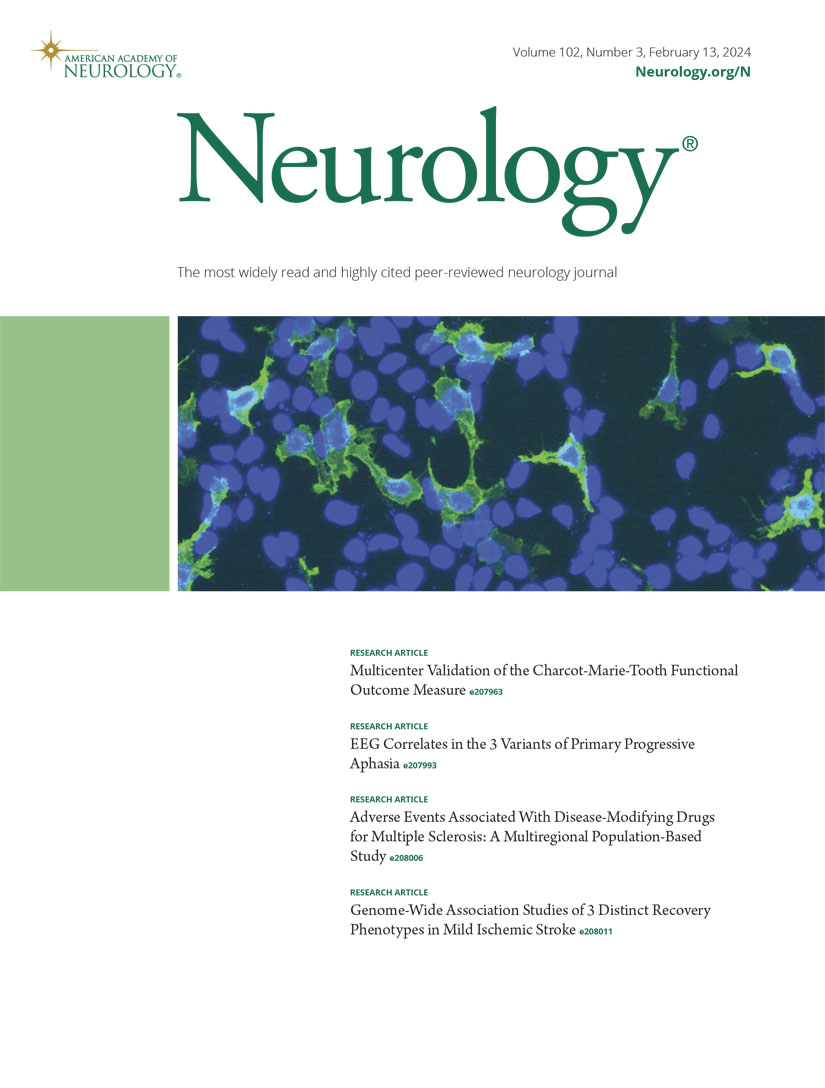Duration of Benefit and Risk of Dual Antiplatelet Therapy up to 72 Hours After Mild Ischemic Stroke and Transient Ischemic Attack.
IF 8.5
1区 医学
Q1 CLINICAL NEUROLOGY
引用次数: 0
Abstract
BACKGROUND AND OBJECTIVES Clopidogrel-aspirin initiated within 72 hours of symptom onset is effective in patients with mild ischemic stroke or transient ischemic attack (TIA) in the Intensive Statin and Antiplatelet Therapy for Acute High-risk Intracranial or Extracranial Atherosclerosis (INSPIRES) trial. Uncertainties remain about the duration of the treatment effect. This study aimed to assess duration of benefit and risk of clopidogrel-aspirin in these patients. METHODS The INSPIRES trial was a 2*2 factorial placebo-controlled randomized trial conducted in 222 hospitals in China. The 2 treatments did not interact and were evaluated separately. In this study, we performed secondary analyses based on antiplatelet treatment. All patients with mild stroke or TIA of presumed atherosclerotic cause within 72 hours of symptom onset enrolled in the trial were included. Patients were randomly assigned to receive clopidogrel-aspirin on days 1-21 followed by clopidogrel on days 22-90 or aspirin alone for 90 days. The primary efficacy outcome was major ischemic event which included the composite of ischemic stroke and nonhemorrhagic death. The primary safety outcome was moderate-to-severe bleeding. We estimated the risk difference between the 2 treatments for each stratified week. RESULTS All 6,100 patients in the trial were included (3,050 in each group). The mean age was 65 years, and 3,915 patients (64.2%) were men. Compared with aspirin alone, the reduction of major ischemic events by clopidogrel-aspirin mainly occurred in the first week (absolute risk reduction [ARR] 1.42%, 95% CI 0.53%-2.32%) and remained in the second week (ARR 0.49%, 95% CI 0.09%-0.90%) and the third week (ARR 0.29%, 95% CI -0.05% to 0.62%). Numerical higher risk of moderate-to-severe bleedings in the clopidogrel-aspirin group was observed in the first 3 weeks (absolute risk increase 0.05% [95% CI -0.10% to 0.20%], 0.10% [95% CI -0.09% to 0.29%], and 0.18% [95% CI -0.03% to 0.40%] in the first, second, and third weeks, respectively). CONCLUSIONS Among patients with mild ischemic stroke or high-risk TIA of presumed atherosclerotic cause, the net benefit of clopidogrel-aspirin initiated within 72 hours of symptom onset was pronounced in the first week and continued to a lesser degree in the following 2 weeks, outweighing the low, but ongoing hemorrhagic risk. TRIAL REGISTRATION INFORMATION ClinicalTrials.gov Identifier: NCT03635749. CLASSIFICATION OF EVIDENCE This study provides Class II evidence that among patients with mild ischemic stroke or high-risk TIA of presumed atherosclerotic cause, the net benefit of clopidogrel-aspirin initiated within 72 hours of symptom onset was pronounced in the first week and continued to a lesser degree in the following 2 weeks, outweighing the low but ongoing hemorrhagic risk.轻度缺血性脑卒中和短暂性脑缺血发作后 72 小时内双重抗血小板疗法的获益时间和风险。
背景和目的:在 "急性高危颅内或颅外动脉粥样硬化的他汀类药物和抗血小板强化疗法"(INSPIRES)试验中,在症状出现 72 小时内开始服用氯吡格雷-阿司匹林对轻度缺血性卒中或短暂性脑缺血发作(TIA)患者有效。治疗效果的持续时间仍存在不确定性。本研究旨在评估氯吡格雷-阿司匹林在这些患者中的获益时间和风险。方法INSPIRES试验是一项2*2因子安慰剂对照随机试验,在中国222家医院进行。两种治疗方法没有相互作用,并分别进行了评估。在本研究中,我们根据抗血小板治疗进行了二次分析。参加试验的所有轻度脑卒中或 TIA 患者均在症状出现 72 小时内接受了推测为动脉粥样硬化引起的治疗。患者被随机分配在第 1-21 天接受氯吡格雷-阿司匹林治疗,然后在第 22-90 天接受氯吡格雷治疗,或在 90 天内只接受阿司匹林治疗。主要疗效指标是主要缺血性事件,包括缺血性中风和非出血性死亡的复合指标。主要安全性结果是中重度出血。我们估算了每个分层周两种治疗方法的风险差异。结果试验共纳入 6100 名患者(每组 3050 名)。平均年龄为 65 岁,3,915 名患者(64.2%)为男性。与单用阿司匹林相比,氯吡格雷-阿司匹林减少主要缺血性事件的效果主要出现在第一周(绝对风险降低[ARR] 1.42%,95% CI 0.53%-2.32%),并在第二周(ARR 0.49%,95% CI 0.09%-0.90%)和第三周(ARR 0.29%,95% CI -0.05%-0.62%)保持不变。在前三周观察到氯吡格雷-阿司匹林组发生中度至重度出血的风险更高(第一周、第二周和第三周的绝对风险增加率分别为 0.05% [95% CI -0.10% to 0.20%]、0.10% [95% CI -0.09% to 0.29%] 和 0.18% [95% CI -0.03% to 0.40%])。结论在推测为动脉粥样硬化引起的轻度缺血性卒中或高危 TIA 患者中,在症状出现 72 小时内开始使用氯吡格雷-阿司匹林的净获益在第一周非常明显,在随后的 2 周内持续获益程度较低,超过了出血风险较低但持续存在的风险:NCT03635749.证据分类本研究提供了II级证据,证明在推测为动脉粥样硬化引起的轻度缺血性中风或高危TIA患者中,在症状出现72小时内开始使用氯吡格雷-阿司匹林的净获益在第一周非常明显,在随后的2周中持续程度较低,超过了较低但持续的出血风险。
本文章由计算机程序翻译,如有差异,请以英文原文为准。
求助全文
约1分钟内获得全文
求助全文
来源期刊

Neurology
医学-临床神经学
CiteScore
12.20
自引率
4.00%
发文量
1973
审稿时长
2-3 weeks
期刊介绍:
Neurology, the official journal of the American Academy of Neurology, aspires to be the premier peer-reviewed journal for clinical neurology research. Its mission is to publish exceptional peer-reviewed original research articles, editorials, and reviews to improve patient care, education, clinical research, and professionalism in neurology.
As the leading clinical neurology journal worldwide, Neurology targets physicians specializing in nervous system diseases and conditions. It aims to advance the field by presenting new basic and clinical research that influences neurological practice. The journal is a leading source of cutting-edge, peer-reviewed information for the neurology community worldwide. Editorial content includes Research, Clinical/Scientific Notes, Views, Historical Neurology, NeuroImages, Humanities, Letters, and position papers from the American Academy of Neurology. The online version is considered the definitive version, encompassing all available content.
Neurology is indexed in prestigious databases such as MEDLINE/PubMed, Embase, Scopus, Biological Abstracts®, PsycINFO®, Current Contents®, Web of Science®, CrossRef, and Google Scholar.
 求助内容:
求助内容: 应助结果提醒方式:
应助结果提醒方式:


